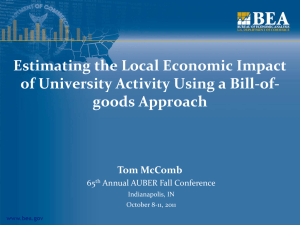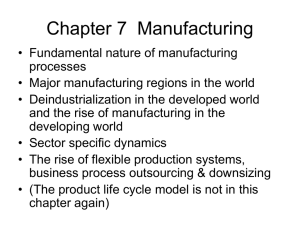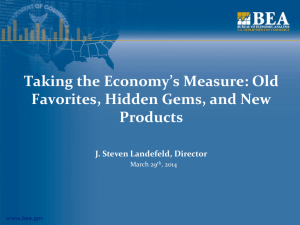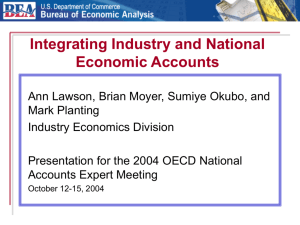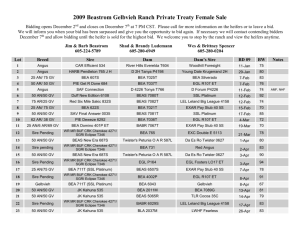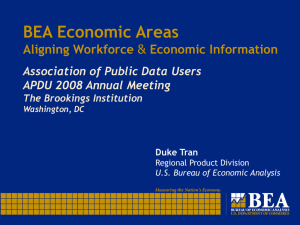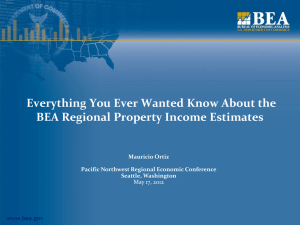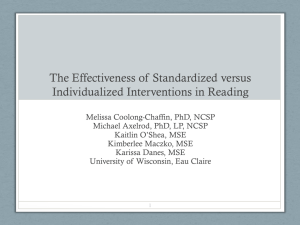Input-Output Models for Impact Analysis: Suggestions for
advertisement
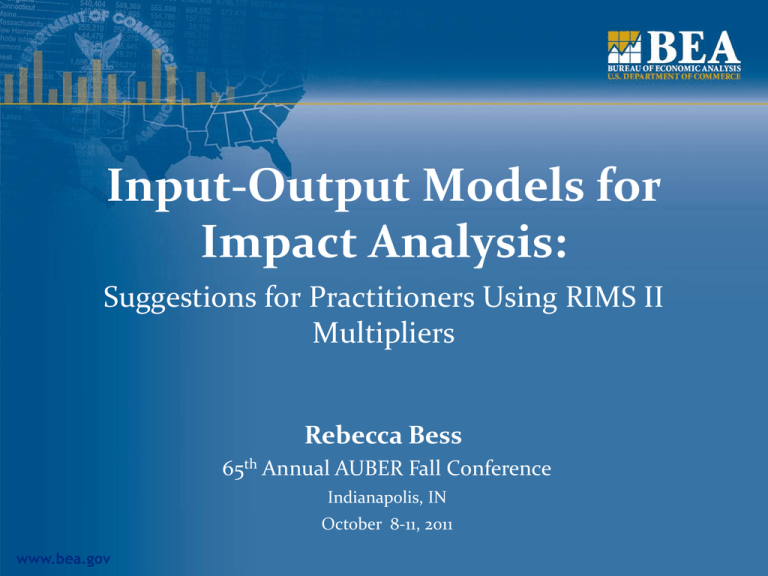
Input-Output Models for Impact Analysis: Suggestions for Practitioners Using RIMS II Multipliers Rebecca Bess 65th Annual AUBER Fall Conference Indianapolis, IN October 8-11, 2011 www.bea.gov Outline of Today’s Talk ▪ ▪ ▪ ▪ ▪ Input-output models Key assumptions Information required from users Multiplier selection Common mistakes www.bea.gov 2 I-O Multipliers ▪ Similarities to macroeconomic multipliers Initial change leads to additional spending Leakages (imports, saving, taxes) ▪ Differences from macroeconomic multipliers Measured inter-industry relationships No supply constraints ▪ Similar results between models more likely when resources are “slack” ▪ Advantages of industry-level detail www.bea.gov 3 Literature Review ▪ Macroeconomic multipliers Kahn (1931); Hall (2005) ▪ I-O multipliers Leontief (1938); Isard (1951); Richardson (1985); Beemiller (1990) ▪ Uses and misuses of multipliers Coughlin and Mandelbaum (1991); Mills (1993); Hughes (2003); Grady and Mullen (1988); Harris (1997); Siegfried, Sanderson, and McHenry (2006) www.bea.gov 4 National Use Table • • • • Intermediate inputs are commodities purchased by industries Value added is the income earned in production, including labor earnings Total gross output = Intermediate Inputs + Value Added GDP = Σ Value added = Σ Final use; GDP ≠ Total gross output www.bea.gov 5 Key Assumptions ▪ ▪ ▪ ▪ ▪ ▪ Backward linkages Fixed production patterns Industry homogeneity Fixed prices and no supply constraints Local supply conditions No regional feedback effects www.bea.gov 6 Information Required from Users ▪ Final-demand change Expressed in terms of output, earnings, or employment Changes in demand from final users Personal consumption expenditures (C) ; Investment in new construction, equipment, software (I); Government (G); Exports (X) ▪ Final-demand industry Detailed or aggregate Consider project phases ▪ Final-demand region Purpose of the study Area of interrelated economic activity Location of industries supplying direct inputs Where most new employees will reside www.bea.gov 7 Multiplier Selection www.bea.gov 8 Common Mistakes ▪ Not taking offsets into consideration ▪ Confusing gross output with regional GDP ▪ Confusing changes in investment with intermediate purchases ▪ Using final-demand changes in purchaser prices ▪ Using a Type II multiplier when a Type I multipliers is more appropriate ▪ Averaging or summing multipliers ▪ Using multipliers to measure industry contributions www.bea.gov 9 Further Suggestions ▪ Avoid using multipliers to estimate the impacts of: single events taking place over a short period of time an industry’s contribution to the economy, especially one of the economy’s largest industries changes large enough to affect the structure of the economy www.bea.gov 10 Thank You Rebecca Bess RIMS II Section, Regional Product Division U.S. Bureau of Economic Analysis Phone: 202-606-5343 E-mail: RIMS@bea.gov www.bea.gov 11
